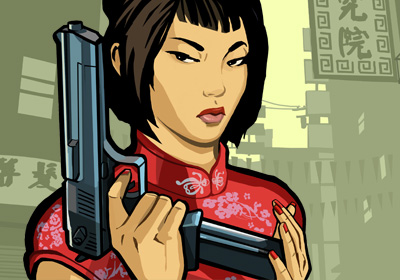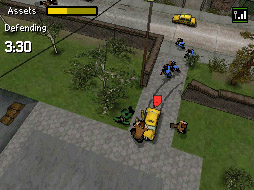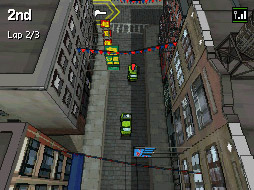
It must be incredibly frustrating for a developer to deliver a game that convincingly nails its design goals, only to see it flounder in the marketplace for reasons beyond their control. This sometimes happens when another game in the publisher’s portfolio has become a smash hit, leading everything else to be neglected regardless of quality. In other cases, the staff who set up and evangelised the project go elsewhere and their replacements don’t share their enthusiasm. Or it could simply be that the game targets a platform or genre where the publisher lacks experience. It’s this last scenario that seems to have soured the fortunes of Grand Theft Auto: Chinatown Wars, Rockstar Games’s first title for the Nintendo DS.
If we consider the hesitant way in which it has been marketed, combined with assumptions about the technical capabilities of the host platform, it’s likely that many potential purchasers have been led to assume that Chinatown Wars is a spin-off sharing no similarities to the 3D GTA games beyond the brand name. The packaging features softer, more cartoon-like artwork than most of the GTA games and a single, thumbnail-sized screenshot of the in-game graphics on the reverse. Even in screenshots and video, the game looks far removed from GTA IV or the rest of the 3D GTAs, lacking the rich colours, iconic screen furniture and sweeping cityscapes that have been the series’s hallmarks since GTA III.
Let’s set this straight once and for all: GTA:CW is a 3D GTA game. It is not a return to the presentation and game mechanics of the 2D GTAs. In mechanical terms, the game plays extremely similarly to GTA III or Vice City (except with the benefit of many new features and refinements, such as being able to restart missions easily and save anywhere). The main technical differences are the camera (which has a locked pitch, limiting the required drawing distance as the game has no LOD system) and the use of sprites instead of polygons for all the little people. There are also no flyable aircraft or 3D building interiors, and cut-scenes are presented in text and still images rather than voiced, motion-captured animations. Aside from that, everything you can do with a weapon, car, bike or boat in the home console GTAs is present and correct in Chinatown Wars.
Rockstar Leeds have examined each element of the GTA gameplay and considered how it could be adapted to the DS controls. There’s a subtle level of steering assistance that lines the player’s car up with the road, obviating a lot of small steering tweaks when turning corners. More significantly, the process of stealing cars has been made more strategic. It’s now possible to hot-wire parked cars (in the form of a brief touchscreen minigame), completely evading police detection at the cost of a few seconds of fiddling about. To balance this, jacking a moving vehicle now attracts police attention in the majority of cases. Additionally, the constrained viewpoint makes it easier to accidentally run over pedestrians or ding police cars. As a result, quite a lot of the time the player will have at least a single-star wanted level.
This is where the game’s mechanics deviate most significantly from GTA tradition. Losing a high wanted level no longer requires driving through ‘bribe’ icons or getting your car resprayed. It’s now possible to lose your wanted level by totalling police cruisers, tricking them into crashing into lampposts and walls in true Blues Brothers / Dukes of Hazzard fashion. While this doesn’t make a great deal of logical sense and removes some of the tension of the cops and robbers dynamic, it does mean that going on a five-star rampage doesn’t inevitably end in arrest or death.
The process of earning money has also been heavily reworked. Performing side missions (taxi driving, firefighting, etc.), robbing people and even completing the main story missions now only offer meagre cash rewards. The game makes it clear that the only way to make serious money in Liberty City is through the new drug dealing system.
This works very similarly to trading goods in Elite. There are 80 dealers hidden around the city, who each offer different selling and buying prices for the game’s six illicit commodities. It’s possible to figure out general trends of which gangs favour which substances, but the fastest way to make money through the system is to follow daily email tip-offs highlighting extremely high buying and low selling prices which are only offered for a limited time. Trying to pull off large deals can also result in police raids, immediately bumping up the wanted level and leaving the player scrambling to get their haul to a safe-house. It’s also possible to hijack rival gangs’ vans to steal their deliveries. These rules create an addictive trade-off of risk and reward. Whenever the player is carrying drugs on their person they risk losing them if they’re busted, heightening the tension whenever the police are alerted.

The story missions benefit from the stripped down game mechanics. There are no street races that degenerate into blind luck thanks to random traffic, no radio controlled helicopters or other half-baked novelty vehicles, and mercifully few escort missions involving fragile vehicles or suicidal AI wingmen. It could be argued that this streamlining goes too far, as many of the later missions boil down to taking a specific vehicle or weapon and killing a set number of attackers. Lots of missions involve one-shot touchscreen minigames (assembling a sniper rifle, arming bombs, tattooing gang members) which add variety without feeling too contrived.
The final mission brings together all the skills that the player has acquired in a frantic chase sequence which is perhaps the best-designed mission I’ve played in a GTA game. In fact this is the only GTA game in which I’ve felt compelled to finish the story missions, probably because it’s the first one where they actually appear to have been play-tested to any degree. The game also gives you the option to replay any mission that you’ve completed. While this is a nice touch, this is still GTA, not Hitman – you can either complete a mission or fail and there’s no incentive to revisit missions such as getting a better ranking or trying different tactics.
With the story missions completed, the game does feel a little empty. There are still the obligatory Rampages, Unique Stunt Jumps, side missions (checkpoint races and the brilliant “Hobotron” – an arena combat game pitting the player against waves of angry tramps) and Easter Egg hunt (locate and destroy 100 CCTV cameras), but the city is quite tightly packed and there’s not a lot of scope for exploration. Drug dealing makes it easy to hoard more money than you can spend. Most of the safe-houses are cheap enough to snap up over the course of the story and weapons and vehicles are negligibly priced and disposable. It would have been nice to have more status symbols (or even abilities) to collect, and more ways to personalise your avatar, vehicles or property.
The graphical limitations take the edge off causing random chaos and police chases. While this aspect of the game is still exciting, it doesn’t provide the same kind of spectacle as the home console versions with their free camera, greater verticality and multi-vehicular pileups. While the 3D engine (and the assets it uses) are visually pleasing (with a day/night cycle, varying weather, and some surprisingly intricate building models), the same can’t be said of the 2D art. The still images used in cut-scenes are indistinct and ugly, seemingly created by taking screenshots of crude 3D models. The effect is reminiscent of the Ubisoft’s XIII, but somehow even uglier. The art used for the touchscreen interludes is similarly cheap-looking, all flat colours and right angles like something out of a bad cartoon-licensed SNES game. Perhaps loading times or memory constraints are to blame, but the 2D graphics jar badly with the quality of the 3D ones.

While the game includes a selection of radio stations playing licensed music (all instrumental), there are no longer any spoof commercials or comedy skits. This absence is (poorly) compensated for in the form of spam emails. The script used in the story missions is uninspiring. None of the characters are particularly likeable, and the dialogue constantly falls back on expletives, single-entendres and self-deprecation without ever being witty or assured enough to get away with it. Luckily there are still a few flashes of the unapologetically silly humour that distinguishes GTA from the myriad clones. (What other game would name a gang of Korean assassins the “Wonsu Nodong”?)
Even with all the bad language and drug references I find it peculiar that the game has somehow managed to earn itself a BBFC 18 certificate. The (textual) swearing is no worse than many 15-rated films. The “drug references” amount to stylised icons in the trading interface, not Trainspotting-style graphic, instructive depictions of drug use. The violence in the cut-scenes is no worse than many (obviously unrated) superhero comics, and in the game itself amounts to eight-pixel-tall stickmen falling over in red blobs. And yet in the BBFC’s eyes this is equivalent to Saw or Manhunt 2.
Rough edges and weak writing aside, one has to admire what Rockstar have achieved with this game. I wouldn’t have thought you could get so close to the console GTA games on the DS, nor that they would have gone to such lengths to adapt the GTA blueprint to work on a handheld. The key to the game’s success as a handheld title is the realisation that challenge should be sought out. Outside of the story missions the game isn’t geared towards punishing the casual player. It’s fun to dip into but has enough deeper content to allow for longer sessions of more structured play. I’d recommend the game to anybody who has enjoyed the best parts of the other GTA games (i.e. treating them as a sandbox), with the above-average story missions being an added bonus.
Tags: Game, game title, grand theft auto, grand theft auto: chinatown wars, GTA, nintendo ds, rockstar, wonsu nodong
